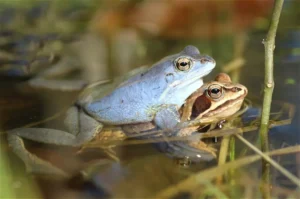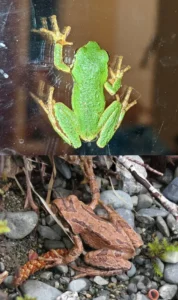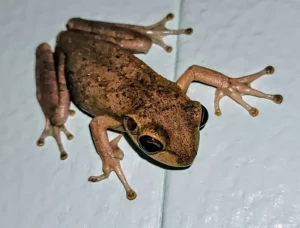Many frogs have a coloration that helps them blend into their environments. Frogs of the same species living in different regions may have variations in fixed color patterns, suited to their specific environments. But can frogs change color?
Many frog species are capable of changing color in response to background color, mood, light, and temperature changes within their environment. Depending on the species, this color change can take a few minutes, hours, or even weeks.
That said, most frogs can not completely change their color. Rather, they can only change to a different shade of their basic color.
For example, American green tree frogs (Hyla cinerea) have a green basic color, but they can change to a shade of yellow, or brown.
However, a few frog species are capable of rapid, dramatic color change.
Many Frog Species Can Change Their Color
There are over 7,000 known frog species around the world, sporting many different colors.
In general, shades of leafy green and muddy brown are naturally the most common colors, as they help frogs blend in with their surroundings.
Many frog species, especially in the tropics, have bright or contrasting colors, such as red, blue, orange, and yellow. In many of these species, the colors let other animals know they are poisonous or dangerous. This is known as warning coloration or aposematism. For example, poison dart frogs (Dendrobatidae).
Some species can also temporarily change their color, almost like a chameleon – to help them blend better into their surroundings.

They can change color either rapidly in response to changes in their immediate environment or slowly as the seasons change.
That said, it’s important to note that even frogs that can “rapidly” change color can not do it within a few seconds like chameleons do.
The color change is more gradual and can take a few minutes, hours, or even weeks depending on the species.
Generally, frogs that are not capable of changing color are known as monochromatic frogs. Those that change color at some point in their life cycle are known as dichromatic frogs.
Frogs that can change color temporarily, before reverting to their old color exhibit dynamic dichromatism.
For some dichromatic frogs, the color change is permanent- meaning when they reach a new life stage, their new shade is irreversible.
Why Do Frogs Change Their Color?
Frogs may change color due to many different factors.
1. Age
Many frog species have significant variations in dominant color depending on age. Younger frogs may be a different color than older frogs of the same species.
For example, young Gray tree frogs (Dryophytes versicolor) are almost always bright emerald green.

Adults, on the other hand, have a varied body coloration, which may range from green to light greenish gray, gray, brown, or dark brown.

Young Cuban tree frogs(Osteopilus septentrionalis), also tend to have more green coloration than adults.
European common toads (Bufo bufo) have significant variation in dominant color depending on age.
2. It’s the Mating Season
Male frogs of many species temporarily change their color during the mating season.
Many frogs mate in crowded pools, where male frogs would be difficult to distinguish from females.
For this reason, some scientists have theorized that the color change during the mating season may be to make breeding more successful.
Male frogs would be able to easily identify female frogs, based on their coloration.
For example, both male and female Moor frogs (Rana arvalis) are reddish-brown for most of the year.
However, during the mating season, males turn a conspicuous blue while females remain brown.

This color change is only for a few days during peak reproductive activity.
Male Moor frogs who have mated appear bluer and have also been recorded as having higher body temperatures.
Male (Rana temporaria) European common frogs turn greyish-blue during the mating season, in contrast to the brownish coloration of the females.

3. Changes in Their Surroundings
Some frog species are capable of slowly changing color in response to the color of their surroundings.
In many species, this color change may happen over several weeks, or even months.
For example, Pacific tree frogs (Pseudacris regilla) can slowly change color throughout a season, to match the general environment.
An area might start out bright green in spring, then slowly dry out during summer, becoming more and more brown.
Pacific tree frogs (Pseudacris regilla) will change their color from green to brown as the season changes, to improve their chance of blending in with the changing environment.

Arum lily reed frogs (Hyperolius horstockii) are also known to change color depending on the seasons.
These frogs are typically ivory white to help them blend into the white blossoms of the arum swamp lily – in which they live.
However, when the blossoms die, the frogs turn brown to match.
4. Changes in the Color of the Background
Some frog species are capable of rapidly changing color, almost chameleon-like, in response to the color of their immediate surroundings.
One frog species capable of such color changes is the Gray tree frog (Dryophytes versicolor).
A gray tree frog may be whitish to gray to blend in with tree bark, or pale green to dark green when resting on foliage. These frogs can change color dramatically in a matter of minutes, though at a slower rate than a chameleon.
American green tree frogs (Hyla cinerea) have also been observed changing their dorsal coloration in response to their background.
A green tree frog may be a vivid shade of lime green when resting on green foliage, but when resting on a tree trunk, it may change into a shade of brown within a span of a few minutes—blending in perfectly with the background.
5. Changes in Temperature
Some frog species can change their color, in response to ambient temperature – becoming darker in cold temperatures, and lighter in warmer temperatures.
Frogs are ectothermic animals, which means their body temperature changes as the temperature in their surroundings changes. Thermoregulation is critical for their activities.
Since dark colors absorb more light energy than light colors, becoming darker is advantageous in colder environments and vice versa.
Some frogs may turn a lighter color in the heat of the day to reflect heat and keep cool.
6. Light, or Time of Day
Some frog species can change their color, depending on the amount of light in their environment.
Modulating the amount of light they absorb by changing their skin color helps maintain an optimal body temperature.
For example, Gray tree frogs (Dryophytes versicolor) tend to become darker at night and lighter in color in sunny areas.
Australian green tree frogs (Litoria caerulea) can also change color based on the lighting in their environment.
7. Changes in Mood
Some frog species can also change color based on their mood.
For example, African clawed frogs (Xenopus laevis), can darken significantly in color when they are disturbed
Red-eyed tree frogs may become a dark green or reddish-brown color, according to their mood,
According to their mood, red-eyed tree frogs can even become a dark green or reddish-brown color.
8. Stress
Some frog species can also change color due to stress.
For example, Barking Tree Frogs (Hyla gratiosa) can change color rapidly from green to a deep purple or brown during periods of stress.
How Do Frogs Change Their Color?
Coloration in animals is produced by reflection and scattering of light by cells and tissues and by absorption of light by chemical pigments within cells of the skin.
In ectotherms such as frogs, cells containing pigments are called chromatophores and are largely responsible for generating skin color.
In frogs, there are three main types of chromatophores:
- Xanthophores, which contain yellow, orange, or red pigments and are found uppermost on the dermis
- Iridophores which lie below the xanthophores, contain colorless stacks of crystals or platelets that reflect and scatter white light up through them. In many North American frogs, iridophores reflect blue light through the yellow pigment cells above to create a green frog.
- Melanophores, which are the deepest pigment cells, contain black and brown melanin pigment.
The melanophores play an important role in color change.
They are large, star-like cells with long “arms” that extend towards the skin’s surface.
Color change occurs due to the movement of “packets” of melanin pigment (melanosomes) within the melanophores.
When melanin pigment is clustered within the center of the cell, the skin appears very pale – and when it is dispersed through the arms of the melanophores towards the skin’s surface, the frog appears dark.
Because the arms of the melanophores extend between and over the other types of chromatophores (generating different colors), varying the degree of dispersion of the melanin can hide or reveal those chromatophores, changing the animal’s color.
Color change may happen due to various “triggers” including temperature or light. However, most importantly, some frogs change color in response to their surroundings.
They need to observe their surroundings so that they know what color to change to. Information about their surroundings is then processed by the brain, and the brain sends signals to chromatophores.
Color change may also occur due to changes in the spacing of the stacks of platelets within the iridophores, which changes the way they reflect and scatter light, and therefore their color.
What Frogs Can Change Their Color?
Although several frog species are capable of changing their dominant color, many species are not capable of changing color.
Below is a table of 21 frog and toad species that are capable of changing their dominant color:
Frog Species |
Mating Color Change |
Temperature Color Change |
Background Color Change |
General Seasonal Color Change |
| Gray tree frog (Dryophytes versicolor) | No | Lighter at higher temperatures & vice-versa | Becomes lighter on brighter backgrounds & vice-versa | Yes |
| Cope’s gray treefrog (Dryophytes chrysoscelis) | No | Lighter at higher temperatures & vice-versa | Becomes lighter on brighter backgrounds & vice-versa | Yes |
| American green tree frog (Hyla cinerea) | No | Lighter at higher temperatures & vice-versa | Becomes lighter on brighter backgrounds & vice-versa | Yes |
| Spring peeper (Pseudacris crucifer) | No | Lighter at higher temperatures & vice-versa | Becomes lighter on brighter backgrounds & vice-versa | Yes |
| Cuban tree frog (Osteopilus septentrionalis) | No | Lighter at higher temperatures & vice-versa | Becomes lighter on brighter backgrounds & vice-versa | Yes |
| Australian green tree frog (Litoria caerulea) | No | Lighter at higher temperatures & vice-versa | Becomes lighter on brighter backgrounds & vice-versa | Yes |
| Pacific tree frog (Pseudacris regilla) | N0 | Green at low temperatures to brown at higher temperatures | Becomes lighter on brighter backgrounds & vice-versa | Yes |
| Squirrel tree frog (Dryophytes squirellus) | No | Lighter at higher temperatures & vice-versa | Becomes lighter on brighter backgrounds & vice-versa | Yes |
| Bird-voiced tree frog (Dryophytes avivoca) | No | Lighter at higher temperatures & vice-versa | Becomes lighter on brighter backgrounds & vice-versa | Yes |
| Barking Tree Frogs (Hyla gratiosa) | No | Lighter at higher temperatures & vice-versa | Becomes lighter on brighter backgrounds & vice-versa | Yes |
| Pine woods tree frog (Dryophytes femoralis) | No | Lighter at higher temperatures & vice-versa | Becomes lighter on brighter backgrounds & vice-versa | Yes |
| Wood frog (Lithobates sylvaticus) | No | No | Becomes lighter on brighter backgrounds & vice-versa | Yes |
| Moor frog (Rana arvalis) | Males turn blue | No | No | No |
| European common frog (Rana temporaria) | Males turn greyish-blue | No | Becomes lighter on brighter backgrounds & vice-versa | Yes |
| Japanese tree frog (Hyla japonica) | No | Lighter at higher temperatures & vice-versa | Becomes lighter on brighter backgrounds & vice-versa | Yes |
| Red-eyed tree frog (Agalychnis callidryas) | No | Lighter at higher temperatures & vice-versa | Becomes lighter on brighter backgrounds & vice-versa | No |
| Peron’s tree frog (Litoria peronii) | No | Lighter at higher temperatures & vice-versa | Becomes lighter on brighter backgrounds & vice-versa | Yes |
| American toad (Anaxyrus americanus) | No | Lighter at higher temperatures & vice-versa | Becomes lighter on brighter backgrounds & vice-versa | Yes |
| Nepal flying frog (Zhangixalus smaragdinus) | No | Lighter at higher temperatures & vice-versa | Becomes lighter on brighter backgrounds & vice-versa | Yes |
| Arum lily reed frog (Hyperolius horstockii) | No | Lighter at higher temperatures & vice-versa | Becomes lighter on brighter backgrounds & vice-versa | Yes |
| European tree frog (Hyla arborea) | No | Lighter at higher temperatures & vice-versa | Becomes lighter on brighter backgrounds & vice-versa | Yes |
1. Gray Tree Frog

Adult Gray tree frogs have a varied body coloration, which may range from green to light greenish gray, gray, brown, or dark brown.
However, they can change color depending on activities and the environment.
A Gray tree frog may be whitish to gray to blend in with tree bark, or pale green to dark green when resting on foliage.
These frogs can change color dramatically in a matter of minutes, though at a slower rate than a chameleon.
Gray tree frogs also tend to be darker when it’s cold, dark, and lighter when it is warm, or bright.
2. American Green Tree Frog

Adult American green tree frogs have a varied body coloration which can range from bright yellow-green, to reddish-brown.
They also have the ability to change color depending on activities and the environment.
A green tree frog may be a vivid shade of lime green when resting on green foliage, but when resting on a tree trunk, it may change into a shade of brown within a span of a few minutes—blending in perfectly with the background.
Like many color-changing frogs, they tend to become darker when it’s cold, or dark, and lighter when it’s warm, or bright.
3. Australian Green Tree Frog

Adult Australian green tree frogs (also called White’s tree frogs), range in color from brownish- or greyish-green to bright emerald green, depending on the light, temperature, and nature of the environment.
Like many frogs, they tend to have darker colors when it’s cold, or dark, and lighter colors when it’s warm, or bright.
4. Red-Eyed Tree Frog

Adult Red-eyed tree frogs have a vibrant green body with blue and yellow stripes on the side.
They can also change color according to light, temperature, and even mood.
In general, Red-eyed tree frogs tend to be lime green during the day, and dark at night. They may even become a dark green or reddish-brown color, according to their mood.
5. Spring Peeper

Adult spring peepers have a brown or tan coloration, but they can also change color, as well as markings, depending on the surrounding colors and temperature.
Like many frogs, they tend to have a lighter coloration when in a bright or warm environment, and a darker coloration when in a colder, or darker environment.
6. Cuban Tree Frog

Adult Cuban tree frogs are mostly gray, brown, or green, but they can change color to better match their environment.
They can change color depending on temperature, and light.
7. Pacific Tree Frog

Most adult Pacific tree frogs are a shade of green or brown, but they change colors over periods of hours and weeks.
In Pacific tree frogs, the change of color is not triggered by color change in their environments, but by a change in background brightness.
A pacific tree frog may be brown in the summer, and bright green in the spring, to better blend into the environment.
A full change in coloration can take from weeks to months, but initial changes can happen in just a few hours.
8. Squirrel Tree Frog

Adult Squirrel tree frogs have several color variations, but most commonly they are green.
They can also change color, between lighter and darker shades of green or brown, depending on temperature, time of day, and other environmental factors.
9. Bird-Voiced Tree Frog

Adult Bird-voiced tree frogs are usually a dappled, pale grey, or brown.
They can change their color from dark gray to light green depending on temperature, background, and activity level.
10. Barking Tree Frog

Adult Barking tree frogs are variable in color and may be bright or dull green, brown, yellowish, or gray.
They can also change color depending on lighting, time of day, temperature, or the surroundings.
Color changes can be rapid, and spots and markings can seem to disappear and reappear over time.
Barking tree frogs may also change color during periods of stress.
11. European Tree Frog

Adult European tree frogs usually have a green coloration, but they can change their color from green to, gray, or tan – depending on the temperature, humidity, or their mood.
Like many frogs, they tend to become darker when it’s cold, or dark, and lighter when it’s warm, or bright.
skin can be green, gray, or tan depending on the temperature, humidity, or mood.
12. Wood Frog

Adult Wood frogs are usually brown, tan, or rust-colored.
Wood frogs have also been found to darken or brighten, in response to their environment.
13. Common Frog

Adult European common frogs vary in color from olive green] to grey-brown, brown, olive brown, grey, yellowish, and reddish-brown.
However, they also can lighten and darken their skin to match their surroundings.
14. American Toad

Adult American toads generally have a brown or gray coloration, although some toads may even be reddish olive or tan.
They can also change their skin color depending on temperature, humidity, and stress.
The color change generally ranges from yellow to brown to black.
Common Questions About Frog Colors
Can frogs change color like chameleons? Some frog species, such as the Gray tree frog can change color, almost like chameleons – to help them blend better into their surroundings. However, the color change happens at a slower rate than a chameleon.
Featured image credit: Tomasz Wilk (CC BY-NC 4.0 DEED)
Sources:
Park, C., No, S., Yoo, S. et al. Testing multiple hypotheses on the colour change of treefrogs in response to various external conditions. Sci Rep 13, 4203 (2023). https://doi.org/10.1038/s41598-023-31262-y
Bell RC, Zamudio KR. Sexual dichromatism in frogs: natural selection, sexual selection and unexpected diversity. Proc Biol Sci. 2012 Dec 7;279(1748):4687-93. doi: 10.1098/rspb.2012.1609. Epub 2012 Sep 19. PMID: 22993253; PMCID: PMC3497084.
Hettyey, A., Herczeg, G., Laurila, A., Crochet, P., & Merilä, J. (2009). Body temperature, size, nuptial colouration and mating success in male Moor Frogs (Rana arvalis). Amphibia-Reptilia, 30(1), 37-43. https://doi.org/10.1163/156853809787392784
Ries, C., Spaethe, J., Sztatecsny, M., Strondl, C. and Hödl, W. (2008), Turning blue and ultraviolet: sex-specific colour change during the mating season in the Balkan moor frog. Journal of Zoology, 276: 229-236. https://doi.org/10.1111/j.1469-7998.2008.00456.x
Duarte, R. C., Flores, A. A. V., & Stevens, M. (2017). Camouflage through colour change: mechanisms, adaptive value and ecological significance. Philosophical Transactions of the Royal Society B: Biological Sciences, 372(1724), 20160342. https://doi.org/10.1098/rstb.2016.0342
Heinen, J. T. (1994). The Significance of Color Change in Newly Metamorphosed American Toads (Bufo a. americanus). Journal of Herpetology, 28(1), 87–93. https://doi.org/10.2307/1564685

